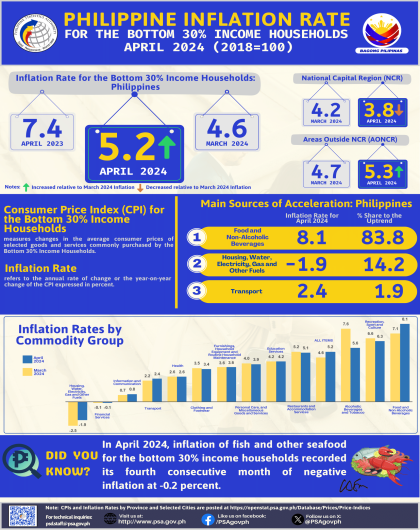1. Philippines
_03_2021_F1.gif)
The country’s inflation rate for the bottom 30% income households was recorded at 5.5 percent in March 2021. This was the same inflation rate noted in February 2021, while it was 2.4 percent in March 2020. (Table A and Figure 1)
Mixed annual movements were observed in the indices of the commodity groups during the period.
Higher inflation were registered in the indices of the following commodity groups during the month:
a. Clothing and footwear, 2.5 percent;
b. Housing, water, electricity, gas, and other fuels, 2.0 percent;
c. Transport, 20.4 percent; and
d. Restaurant and miscellaneous goods and services, 4.4 percent.
On the other hand, slower annual increases were seen in the indices of food and non-alcoholic beverages at 5.3 percent; alcoholic beverages and tobacco, 13.2 percent; and health, 2.7 percent. Moreover, the index of recreation and culture exhibited an annual drop of -0.3 percent in March 2021 from a zero percent annual growth in the previous month.
The indices of the rest of the commodity groups, namely, furnishing, household equipment, and routine maintenance of the house; communication; and education retained their previous month’s annual growth rates. (Tables 3 and 4)
Food inflation at the national level slowed down to 5.5 percent in March 2021. In the previous month, the annual rate of food index was 5.8 percent and in March 2020, 1.0 percent. (Table 7)
Annual increments were slower in the indices of the following food groups during the month:
a. Milk, cheese, and eggs, 2.7 percent;
b. Fruits, 8.3 percent;
c. Vegetables, 12.6 percent; and
d. Food products, not elsewhere classified, 4.9 percent.
Meanwhile, higher annual rates of increases were recorded in the indices of the following food groups in March 2021:
a. Rice, 1.3 percent;
b. Corn, 4.9 percent;
c. Meat, 18.4 percent; and
d. Oils and fats, 5.3 percent.
The indices of the rest of the food groups moved at their February 2021 annual growth rates. (Table 5)
| Table B. Year-on-Year Inflation Rates of the CPI for the Bottom 30% Income Households in the Philippines, All Items January 2017 – March 2021 (2012=100) | |||||
| Month | Year | ||||
| 2017 | 2018 | 2019 | 2020 | 2021 | |
| January | 2.0 | 3.6 | 5.2 | 2.3 | 4.9 |
| February | 2.2 | 4.4 | 4.3 | 2.1 | 5.5 |
| March | 2.2 | 5.0 | 3.4 | 2.4 | 5.5 |
| April | 2.4 | 5.2 | 3.1 | 2.9 | |
| May | 2.1 | 5.4 | 3.2 | 2.9 | |
| June | 2.1 | 5.4 | 3.1 | 3.0 | |
| July | 1.9 | 6.2 | 2.5 | 2.9 | |
| August | 2.3 | 6.9 | 1.7 | 2.7 | |
| September | 2.5 | 8.0 | 0.2 | 2.8 | |
| October | 2.7 | 8.1 | -0.1 | 2.9 | |
| November | 2.6 | 7.3 | 0.7 | 3.6 | |
| December | 2.7 | 6.3 | 1.9 | 4.3 | |
| Average | 2.3 | 6.0 | 2.4 | 2.9 | |
Source: Survey of Retail Prices of Commodities for Consumer Price Index, Philippine Statistics Authority
2. National Capital Region (NCR)
Inflation of consumer items for the bottom 30% income households in NCR decelerated further to 5.0 percent in March 2021. Inflation in the region in the previous month was 6.0 percent and in the same month in 2020, 1.9 percent. (Tables A and 3)
Annual hikes slowed down in the indices of the following commodity groups during the month:
a. Food and non-alcoholic beverages, 6.0 percent;
b. Alcoholic beverages and tobacco, 13.2 percent;
c. Clothing and footwear, 0.8 percent;
d. Housing, water, electricity, gas, and other fuels, 0.9 percent; and
e. Restaurant and miscellaneous goods and services, 1.4 percent.
On the contrary, higher annual increases were registered in the indices of health at 1.8 percent; and transport, 25.0 percent.
The indices of the rest of the commodity groups retained their previous month’s annual growth rates. (Tables 3 and 4)
3. Areas Outside NCR (AONCR)
Following the trend of the national level, inflation for this particular income group of consumers in AONCR moved at 5.5 percent in March 2021, the same annual rate recorded in the previous month. In March 2020, inflation for the bottom 30% income households in AONCR was posted at 2.4 percent. (Tables A and 3)
Annual increments were higher in the indices of the following commodity groups during the month:
a. Clothing and footwear, 2.6 percent;
b. Housing, water, electricity, gas, and other fuels, 2.0 percent;
c. Transport, 20.2 percent; and
d. Restaurant and miscellaneous goods and services, 4.6 percent.
On the other hand, annual hikes slowed down in the indices of the following commodity groups in March 2021:
a. Food and non-alcoholic beverages, 5.2 percent;
b. Alcoholic beverages and tobacco, 13.2 percent;
c. Furnishing, household equipment, and routine maintenance of the house, 1.7 percent; and
d. Health, 2.7 percent.
Annual rates in the indices of communication and education remained at 0.5 percent and 1.5 percent, respectively, while the index of recreation and culture exhibited an annual drop of -0.3 percent during the month. (Tables 3 and 4)
Seven regions in AONCR had higher inflation for the bottom 30% income households in March 2021. The highest inflation among the regions outside NCR during the month remained in Region II (Cagayan Valley) at 8.0 percent, while the lowest inflation was still observed in Region IX (Zamboanga Peninsula) at 1.7 percent. (Table 4)
Note:
Consumer Price Indices (CPIs) and inflation rates for the bottom 30% income households by province and selected city are posted at the Philippine Statistics Authority (PSA) website (http://openstat.psa.gov.ph/).
See more at the Consumer Price Index for Bottom 30% Income Households Main page.

